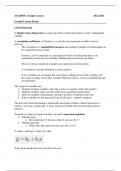All ARMS: Grasple Lessons 2022-2023
Grasple Lessons Recap
Linear Regression
A Simple Linear Regression is used to describe a model where there is only 1 independent
variable.
A correlation coefficient, or Pearson’s r, is used for two numerical variables (ratio or
interval)
The correlation is a standardized measure and multiple strengths of relationships can
be compared because of that.
However, a low correlation or a correlation of 0 does not mean that there is no
correlation between the two variables. Relationship can also be non-linear.
Thus, it’s always important to graph your regression and create plots.
A correlation is not per definition a causal relation!
If two variables are correlated, this means that a change in one of the variables will
also mean a change in the other variable. What the cause is, can be concluded through
an experiment.
The 4 types of variables are
1. Nominal (random variables with only a name, no specific order, like gender)
2. Ordinal (variables with a specific order but no quantitative properties)
3. Interval (variables with quantity, but don’t go below 0 and have intervals)
4. Ratio (variables on the numerical scale of all ratio’s, ‘normal’ numbers)
The first step when determining a relationship and seeing whether a linear regression is
useful, is to create a scatter plot. A linear regression should only be performed on linear
relations.
To predict a value on a regression line, you need a regression equation.
1. Find the slope
a. How much does Y increase when X increases by 1?
2. Find the intercept
a. Where does the regression line cross the y-axis?
Y-value = intercept + slope x X-value
Y hat means predicted score, not observed score.
,To determine how to draw the best suited regression line in a graph with a lot of data points,
we use the least squares method.
Error, or residual.
A residual can be positive or negative, whenever when adding these together the sum could
end up being 0 without it being the most fitting line.
When you square the errors, they will always be positive and not cancel each other.
Smallest possible sum of squared errors.
Least squares method.
To find the slope of the regression model, find the Unstandardized B Coefficient in the table.
To find the intercept of the regression model, find the Intercept in the table.
Fit of the model, goodness of fit can be assessed through a number, for example R-squared.
R^2 determines the proportion of variance of the response variable that is ‘explained’
by the predictor variable(s).
The R-squared is a proportion between 0 and 1.
If the R-squared is very large, is does not necessarily mean that the model is useful for
predicting new observations, and same goes for a low R-squared being bad for
predicting.
,JASP Introduction
It is not possible to change the data in the original file in JASP alone!
To analyze data, you can use descriptive statistics and graphs.
Descriptives > Descriptive Statistics
Bayesian Hypothesis testing and the Bayes Factor
Usually, you do
Research question > Null-hypothesis (H0) > Test > Accept or reject (based on p-value)
This is called Null Hypothesis Significance Testing (NHST)
NHST implies that you can only say, ‘nothing is there’ or ‘something is there’, and if
there is, effect sizes such as Cohen’s d are examined.
This can create problems for scientists, as they have pressure to report significant
findings.
Problems with NHST are
• Publication bias
• Sloppy science
o Questionable research practices, such as choices in data processing to increase
chance of significant findings
• Replication crisis
o Much research cannot be replicated with the same results
Bayesian Way can help with this.
In Bayesian Hypothesis Testing, we check how much evidence there is in the data for one
hypothesis versus another hypothesis. The measure of relative support is called the Bayes
Factor.
The Bayes Factor tells us how much more one hypothesis is supported in comparison to
another.
A BF H0 HA = 5 means there is 5 times more support for H0 than HA.
, The support that we find in the data for a hypothesis is dependent on 2 things:
1. The fit of the hypothesis to the data
2. The specificity of the hypothesis
ANOVA and Error rates
An ANOVA is a test for comparing 2 or more means.
One can also use a t-test, like for 2 paired samples, or 2 independent samples.
A t-test used for 2 independent samples (and assuming equal population variances for
the outcome variable in the compared groups) is equivalent to an ANOVA when used
for 2 groups.
A first extension of an ANOVA is that also 3 or more groups can be compared, unlike
t-test.
Differences in sample means do not automatically imply that this difference is valid for the
entire population.
There will always be a sampling variation. This implies that the results in a next
sample from the same population will be somewhat different. This is called sampling
variability, or sampling error.
Analysis Of VAriance.
The assumptions for an ANOVA are:
1. Within each group, the scores for the dependent variable are normally distributed.
2. There are no outliers in the scores of the people on the dependent variable.
3. The variance of the scores on the dependent variable are the same in each group.
4. The scores of the people on the dependent variable are mutually independent.
Violation of 2 & 4 will always be problematic for interpretation of results!




